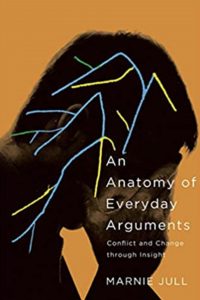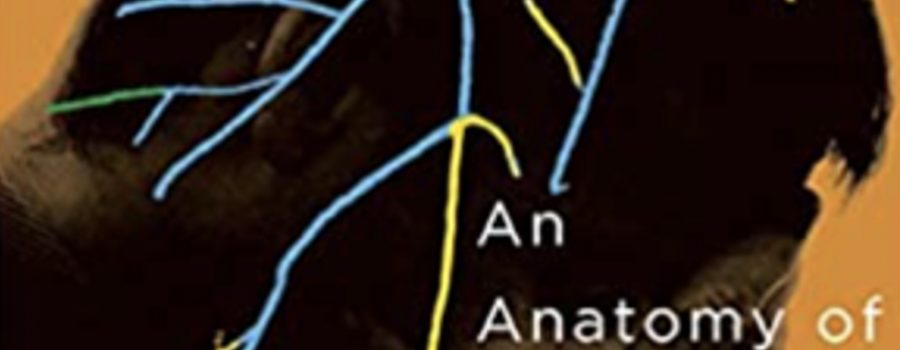BOOK REVIEW

An Anatomy of Everyday Arguments: Conflict and Change through Insight
Marnie Jull
McGill-Queen’s University Press, 2022
ISBN-10 : 022800845X
ISBN-13 : 978-0228008453
Reviewed by: Demi Peters, Q.Med
This book is an academic look at what is called “the Insight approach” to conflict. In a brief but dense introspective piece, Jull examines four different conflicts through that lens. New to the approach, I found the writing deeply insightful and informative, but wished that prior to reading the book I had read more rudimentary materials on the subject; I often felt that Jull’s presentation and application of the Insight approach were beyond my understanding.
Jull begins An Anatomy of Everyday Arguments with an introduction that invites the reader who “prefers story before theory” to begin at chapter four and then return to the earlier chapters where the theoretical and methodological aspects of the Insight approach are outlined. As a reader who enjoys a good story, I appreciated this invitation. However, I did not accept it and was glad to have made my way through the theoretical and methodological explanations, as I was completely unfamiliar with the Insight approach.
In Chapter 1, Jull uses the term “Autoethnography,” which was a new word for me. Autoethnography, she explains, is how she will convey the stories of conflict and apply the Insight approach. In the following chapter, she outlines the key concepts of the Insight approach, stating at page 20, “The Insight approach pays attention to individual decision making as a focus of analytical attention, recognizing that conflict behaviour is an enactment of a decision made by individuals that takes place within the social roles that we enact (M. Price 2019; Peddle 2020).” Chapter 2 was extremely valuable to me because my exposure to the Insight approach prior to reading this book was zilch.
Whether a reader chooses to take Jull’s invitation to initially skip to the stories or opts to read cover to cover, I would encourage any reader to read, and possibly even re-read Chapter 2 together with the appendix that includes a diagram of the “Insight Loop.” These helped me understand Jull’s academic analysis of the conflicts she described, as well as give me some understanding of the Insight approach to conflict.
Chapter 3 contains Jull’s methodological preface to the cases she examines in the book. Then, in the following four chapters she shares experiences she has had with various conflicts from multiple perspectives—that of a participant in a conflict, of an observer, and of a dispute resolution facilitator. In each story Jull analyzes the experience of conflict and focuses on how the Insight approach expands the possibilities of understanding between parties and provides more opportunities for resolution than if participants stayed in their own space of incuriosity and valuing.
Chapter 4 describes an interpersonal conflict between Jull and her partner. In this touching and light-hearted example, Jull examines resolving conflict when no change in values or even agreement happens. Instead, what transpires is a deeper understanding of the other side.
Chapter 5 describes Jull’s internal conflict relating to her daughter’s involvement in a competitive hockey league. In this example, Jull examines expanding horizons of possible questions and considerations, and concludes that conflict is not necessarily bad, among other things related to the situation.
Chapter 6 describes Jull’s interaction with a friend regarding a conflict her friend is experiencing in his role as a consultant. In this chapter what struck me was Jull’s reflection about “self-referencing” compared to understanding someone “on their own terms” (page 89), and her determination that neither is inherently bad or good; each has its place and understanding someone “on their own terms” is likely more appropriate for individuals acting in the role of a mediator.
The final example Jull uses is a one where Jull acts as a group facilitator. At the end of this case study Jull shares, “I’m starting to think that maybe putting more compassion into systems like these can often produce better outcomes…” to which a participant in the facilitation responds, “When a person believes they are on the receiving end of compassion from another person, suddenly the world becomes a safer place…” (page 115). I thought that this exchange was a lovely way of wrapping up the narrative portion of Jull’s writing.
Jull concludes her book with a chapter on “Implications for Inquiry” and “Implications for Conflict Analysis,” along with a conclusion, providing a summary and further reflection on the examples in the book and how the Insight approach assisted the people, including herself, in the experience of the conflict. In italics on pages 154 and 155 she includes an adorable personal story of a conflict between herself and her daughter, describing an altercation regarding bedtime, while she herself is trying to finish writing the book. This piece was endearing to me because I found myself in a similar situation as I sat at my kitchen table writing this review
As I mentioned, I was unfamiliar with the Insight approach prior to reading this book, though I was trained in various other styles and models of mediation. This type of deep, academic examination of an approach to conflict is most appropriate for a seasoned mediator or seasoned student of dispute resolution. As Jull describes on pages 140 and 141, when teaching conflict and communication, the explanation of how to “open up” a question is very basic, but it “lacks complexity, precision, context, and interiority” (page 140). This book, as Jull writes in her conclusion, is more about a deeper “method of discovery” (page 141), than “a list of techniques” (page 141). Thus, for the new mediator, I would suggest saving this read until after mastery of the basics is reached, and I would encourage the advanced mediator to engage with this book for the interesting implementation of the Insight approach and the academic lens with which conflict is examined.

Demi Peters, Q.Med
Demi Peters is a Qualified Mediator and dispute resolution educator from Saskatoon, Saskatchewan and a member of the ADR Institute of Saskatchewan.

